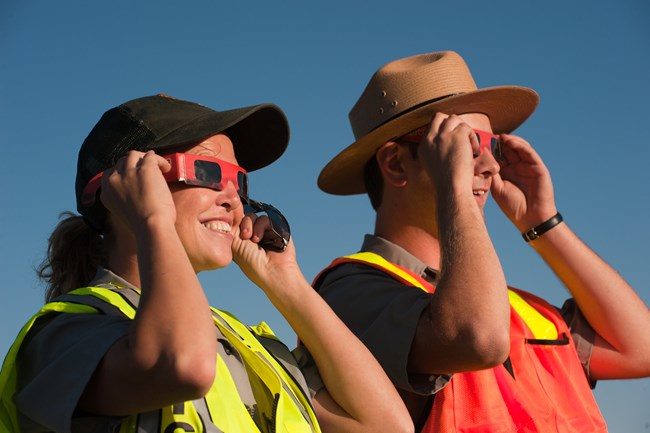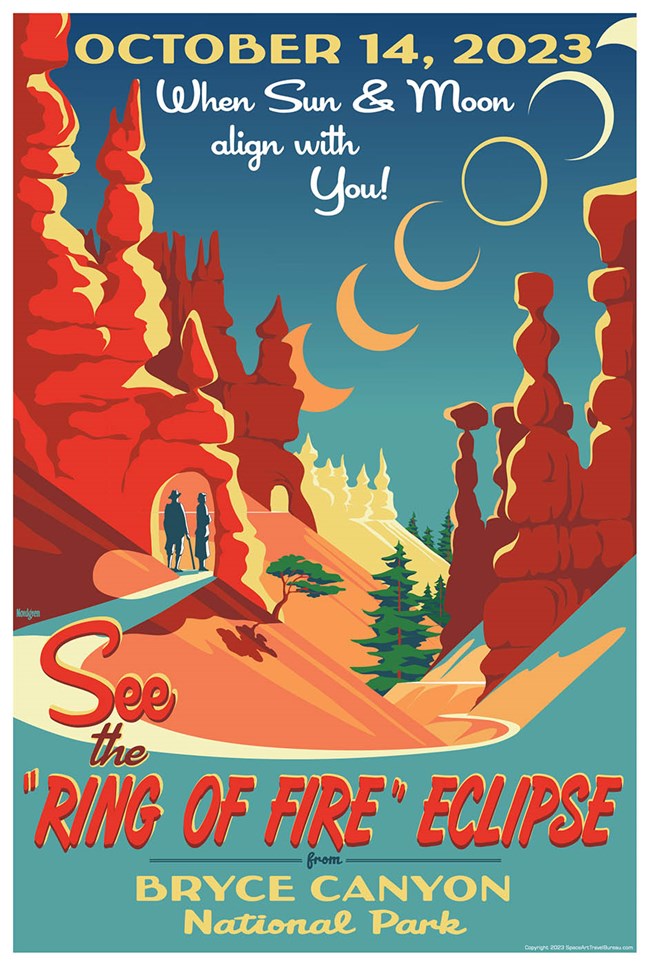
NPS/Kevin Doxstater 
NPS Photo/Neal Herbert A Centennial EclipseWhat better way to end Bryce Canyon's major centennial events than with an eclipse? This year, the U.S. will see its first annular solar eclipse since 2012! It will begin on Saturday, Oct. 14, 2023, beginning in Oregon and ending in Texas. Weather permitting, the eclipse will be visible in Bryce Canyon starting at 9:09 a.m. MDT and ending at 11:56 a.m., with the maximum eclipse of 90% being at 10:28 a.m. Did you know?The Bryce Canyon area experienced an eclipse exactly 100 years ago! On September 10, 1923 a total solar eclipse passed along the edge of the Pacific coast. What is an Annular Eclipse?An annular solar eclipse happens when the Moon passes between the Sun and Earth while it's at its farthest point from Earth. Because the Moon is farther away from Earth, it appears smaller than the Sun and does not completely cover it. This creates a “ring of fire” effect in the sky. What to ExpectThe 2012 annular eclipse brought over 10,000 visitors to Bryce Canyon National Park. Public awareness of eclipses has only grown in the years since, and while the park has no official estimates for visitation we expect it to be a very busy day. There is a high likelihood that parking capacity will be reached early in the morning, requiring a restriction of private vehicle entries. This makes the Bryce Canyon shuttle and shared-use bike path the most reliable ways to enter the park and reach its most popular overlooks. Bringing your annual or lifetime pass, or purchasing a digital pass in advance can also save time. 
TransportationShuttle buses will run from 6 a.m. to 6 p.m. on October 14. Due to expected high visitation, from 6 a.m. until around 3 p.m. the Bryce Canyon Shuttle will operate on a special eclipse route. This route will exclude some normal stops so as to prioritze Bryce Amphitheater viewpoints. All inbound and outbound shuttles will transfer at the Visitor Center. Special ProgramsNo reservations are needed for programs, however seating will be first-come, first-seated. Capacity in the Lodge Auditorium is 140 people. October 13The park will provide a special moon-based evening program titled "Live by the Sun, Love by the Moon" on October 13 featuring NASA Lunar Scientist Dr. Barbara Cohen. This program will be open to the public, held at 8 p.m. in the Lodge Auditorium. October 14The night of October 14 will feature a special "Astrophysicist Q&A Panel" where members of the public can just ask a panel of astrophysicists various questions in a public forum. The panel will be led by Cameron Hummels, Director of Astrophysics Outreach at Caltech at 8 p.m. in the Lodge Auditorium. Where to ViewThere will be no special areas designated for eclipse viewing, and visitors are welcome to enjoy the eclipse in any area of the park normally open to the public. 
Tyler Nordgren Stay Safe and Protect your ParkCamping & LodgingIf the park doesn't experience any significant snowfall leading up to the eclipse, both developed campgrounds will be open. Both campgrounds will be first-come, first-served. Camping outside of established campgrounds is strictly prohibited within the bounds of Bryce Canyon National Park. For camping options outside the park visit the Garfield County tourism page. Safe Viewing PracticesAnnular eclipses differ from total eclipses in that at no point is it safe to view the sun without properly rated eye protection! We want to ensure everybody has a safe morning and the equipment to do so! Sunglasses are not sufficient protection for viewing the sun. Emergency AssistanceIN CASE OF EMERGENCY, ALWAYS CALL 911 OR SEEK OUT PARK STAFF Important InformationCheck out the drop-down menus below for additional important information. What You Need to Know Your view of the eclipse depends on your location and the weather.
Bryce Canyon is located on the path of annularity across North America which means it is one of the locations on Earth from which the Moon will appear to pass directly across the center of the Sun. First Contact 9:09 a.m.: The first phase is called a "Partial Eclipse". This is when the Moon begins to pass in front of the Sun, slowly blocking more and more of the Sun’s light, making the Sun appear as a crescent getting smaller and smaller until it forms a “C” shape. Second Contact 10:28 a.m.: "Annularity" is when the Moon passes completely in front of the Sun, leaving a ring of Sun visible from behind the Moon. This is the second phase of the eclipse and it lasts between 1 and 5 minutes, depending on where you're viewing it from. Here at Bryce Canyon it will be about 3 minutes. During the eclipse, the sky will grow dimmer and animals might behave as if it is dusk. Third Contact 10:31 a.m.: The Moon will continue to move across the sun for about an hour and 20 minutes, producing another Partial Eclipse. Fourth Contact 11:58 a.m.: The Moon will continue to move until it no longer overlaps the sun, ending the eclipse. There will be no special areas designated for eclipse viewing, and visitors are welcome to enjoy the eclipse in any area of the park normally open to the public. The park will maximize the capacity of its public transportation system to best service eclipse visitors. Riding the Bryce Canyon shuttle from the shuttle station just north of the park or using the shared-use bike path are the most reliable ways to enter the park.
In 2012 over ten thousand people came to experience an annular eclipse. While we don't have an estimate for this year's visitation, the expectation is that we will exceed this number. This has the potential to be one of the busiest single days in the park's history. Food Services At this time no official telescope areas have been designated. Camping regulations will remain unchanged, and visitors camping overnight can only do so in provided campsites. Camping at park viewpoints and along trails is not permitted. Yes. No reservations are needed for programs, however seating will be first-come, first-seated. Capacity in the Lodge Auditorium is 140 people. October 13The park will provide a special moon-based evening program titled "Live by the Sun, Love by the Moon" on October 13 featuring NASA Lunar Scientist Dr. Barbara Cohen. This program will be open to the public, held at 8 p.m. in the Lodge Auditorium. October 14The night of October 14 will feature a special "Astrophysicist Q&A Panel" where members of the public can just ask a panel of astrophysicists various questions in a public forum. The panel will be led by Caltech postdoctoral fellow Cameron Hummels at 8 p.m. in the Lodge Auditorium. Yes. Special eclipse and centennial merchandise including glasses, unique artwork, and more will be available in the Bryce Canyon Association bookstore at the Visitor Center. A limited number of eclipse glasses will be available for purchase at the park Visitor Center, however we strongly recommend bringing your own pair. Roving volunteers may have a limited number of glasses to share, but one shouldn't count on these being available. The Sun is never fully blocked by the Moon during the eclipse, therefore, it is never safe to view the sky without specialized eye protection designed for solar viewing. Viewing any part of the eclipse through a camera lens, binoculars, or a telescope will cause immediate severe eye injury.
To safely watch the eclipse directly with your eyes, you must use solar viewing glasses ("eclipse glasses") or a handheld solar viewer at all times. Sunglasses, no matter how dark, are not safe to use for viewing the eclipse. If you don't have eclipse glasses or a solar viewer, you can use indirect viewing methods to watch the eclipse. One method is to create a pinhole projector, which has a small opening (like a hole punched out of cardboard), that you can use to project the Sun onto a nearby surface. Stand with your back towards the sun and view the projected image. Never look at the sun through the opening. Finally, don't forget to wear SPF! If you're viewing the entire eclipse, you will be outside for several hours so remember to wear protective clothing, a hat, and sunscreen to prevent skin damage. |
Last updated: October 11, 2023
